FORD E SERIES 2014 4.G Owners Manual
Manufacturer: FORD, Model Year: 2014, Model line: E SERIES, Model: FORD E SERIES 2014 4.GPages: 438, PDF Size: 5.12 MB
Page 151 of 438
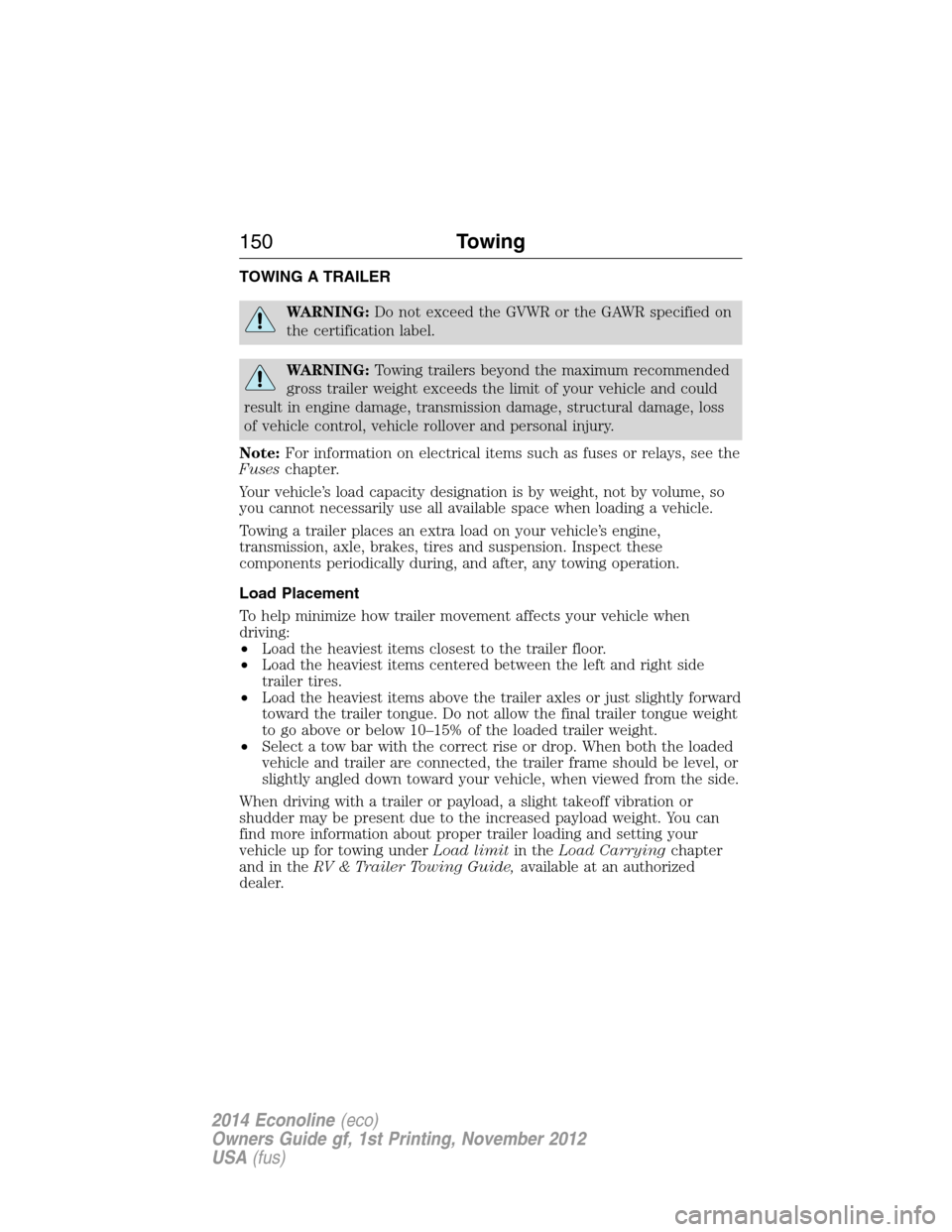
TOWING A TRAILER
WARNING:Do not exceed the GVWR or the GAWR specified on
the certification label.
WARNING:Towing trailers beyond the maximum recommended
gross trailer weight exceeds the limit of your vehicle and could
result in engine damage, transmission damage, structural damage, loss
of vehicle control, vehicle rollover and personal injury.
Note:For information on electrical items such as fuses or relays, see the
Fuseschapter.
Your vehicle’s load capacity designation is by weight, not by volume, so
you cannot necessarily use all available space when loading a vehicle.
Towing a trailer places an extra load on your vehicle’s engine,
transmission, axle, brakes, tires and suspension. Inspect these
components periodically during, and after, any towing operation.
Load Placement
To help minimize how trailer movement affects your vehicle when
driving:
•Load the heaviest items closest to the trailer floor.
•Load the heaviest items centered between the left and right side
trailer tires.
•Load the heaviest items above the trailer axles or just slightly forward
toward the trailer tongue. Do not allow the final trailer tongue weight
to go above or below 10–15% of the loaded trailer weight.
•Select a tow bar with the correct rise or drop. When both the loaded
vehicle and trailer are connected, the trailer frame should be level, or
slightly angled down toward your vehicle, when viewed from the side.
When driving with a trailer or payload, a slight takeoff vibration or
shudder may be present due to the increased payload weight. You can
find more information about proper trailer loading and setting your
vehicle up for towing underLoad limitin theLoad Carryingchapter
and in theRV & Trailer Towing Guide,available at an authorized
dealer.
150Towing
2014 Econoline(eco)
Owners Guide gf, 1st Printing, November 2012
USA(fus)
Page 152 of 438
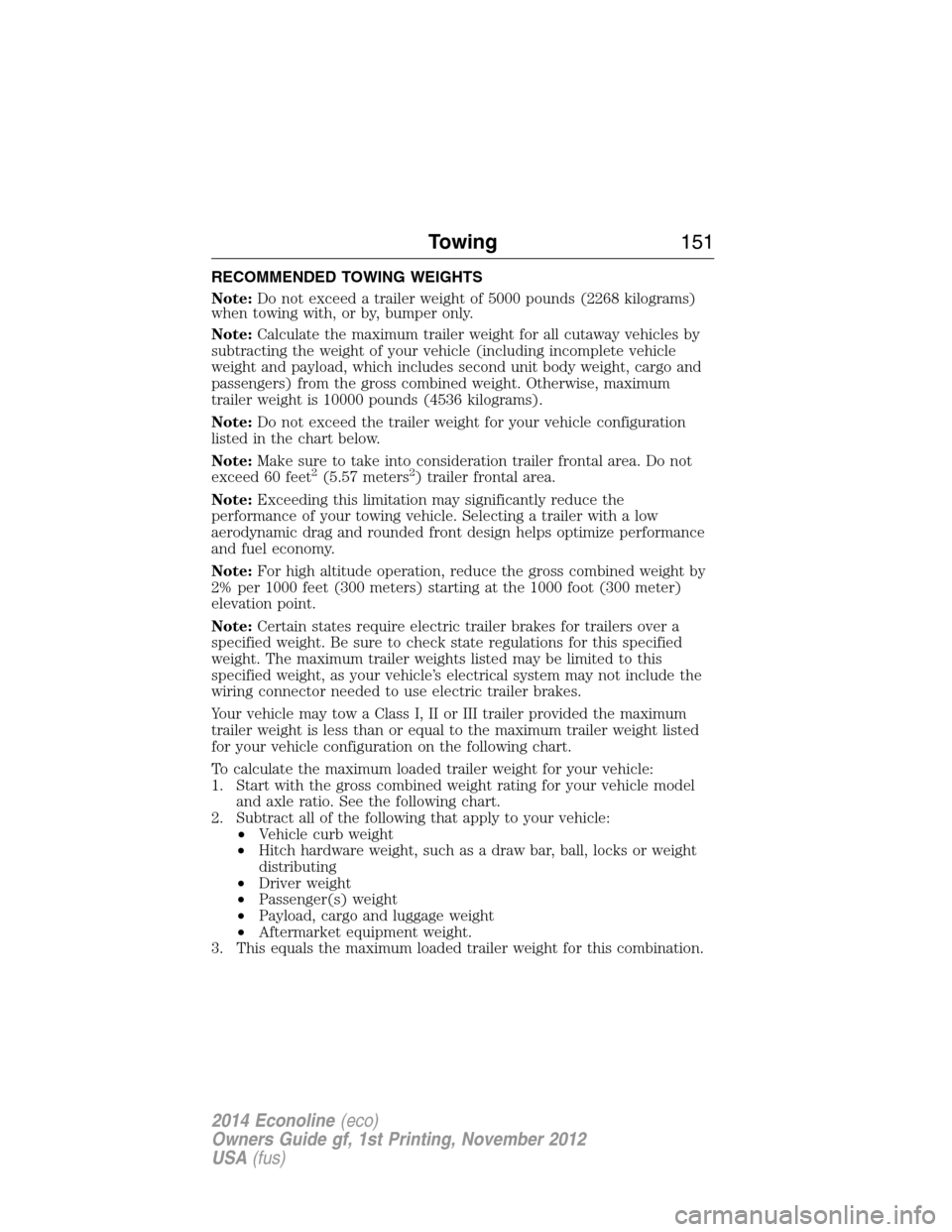
RECOMMENDED TOWING WEIGHTS
Note:Do not exceed a trailer weight of 5000 pounds (2268 kilograms)
when towing with, or by, bumper only.
Note:Calculate the maximum trailer weight for all cutaway vehicles by
subtracting the weight of your vehicle (including incomplete vehicle
weight and payload, which includes second unit body weight, cargo and
passengers) from the gross combined weight. Otherwise, maximum
trailer weight is 10000 pounds (4536 kilograms).
Note:Do not exceed the trailer weight for your vehicle configuration
listed in the chart below.
Note:Make sure to take into consideration trailer frontal area. Do not
exceed 60 feet
2(5.57 meters2) trailer frontal area.
Note:Exceeding this limitation may significantly reduce the
performance of your towing vehicle. Selecting a trailer with a low
aerodynamic drag and rounded front design helps optimize performance
and fuel economy.
Note:For high altitude operation, reduce the gross combined weight by
2% per 1000 feet (300 meters) starting at the 1000 foot (300 meter)
elevation point.
Note:Certain states require electric trailer brakes for trailers over a
specified weight. Be sure to check state regulations for this specified
weight. The maximum trailer weights listed may be limited to this
specified weight, as your vehicle’s electrical system may not include the
wiring connector needed to use electric trailer brakes.
Your vehicle may tow a Class I, II or III trailer provided the maximum
trailer weight is less than or equal to the maximum trailer weight listed
for your vehicle configuration on the following chart.
To calculate the maximum loaded trailer weight for your vehicle:
1. Start with the gross combined weight rating for your vehicle model
and axle ratio. See the following chart.
2. Subtract all of the following that apply to your vehicle:
•Vehicle curb weight
•Hitch hardware weight, such as a draw bar, ball, locks or weight
distributing
•Driver weight
•Passenger(s) weight
•Payload, cargo and luggage weight
•Aftermarket equipment weight.
3. This equals the maximum loaded trailer weight for this combination.
Towing151
2014 Econoline(eco)
Owners Guide gf, 1st Printing, November 2012
USA(fus)
Page 153 of 438
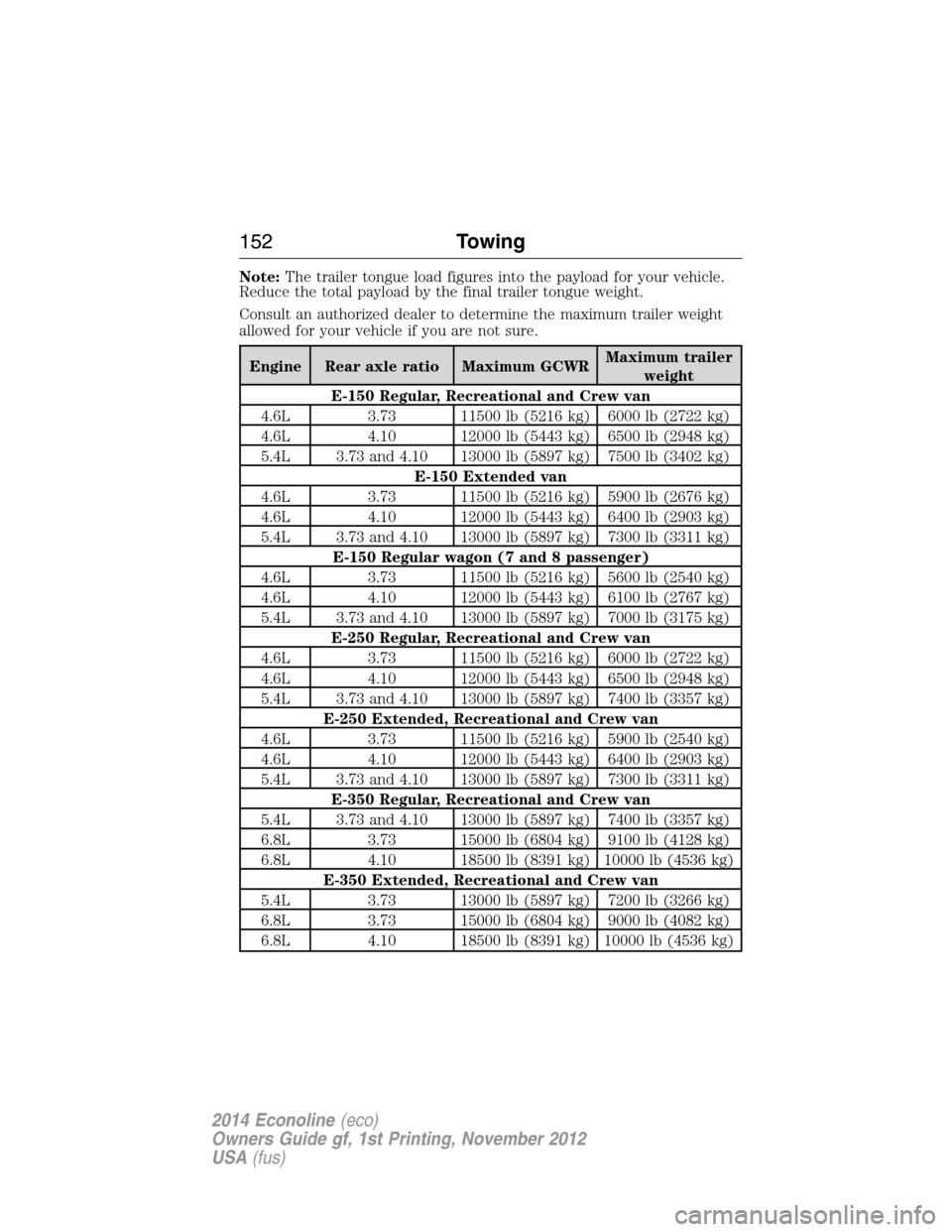
Note:The trailer tongue load figures into the payload for your vehicle.
Reduce the total payload by the final trailer tongue weight.
Consult an authorized dealer to determine the maximum trailer weight
allowed for your vehicle if you are not sure.
Engine Rear axle ratio Maximum GCWRMaximum trailer
weight
E-150 Regular, Recreational and Crew van
4.6L 3.73 11500 lb (5216 kg) 6000 lb (2722 kg)
4.6L 4.10 12000 lb (5443 kg) 6500 lb (2948 kg)
5.4L 3.73 and 4.10 13000 lb (5897 kg) 7500 lb (3402 kg)
E-150 Extended van
4.6L 3.73 11500 lb (5216 kg) 5900 lb (2676 kg)
4.6L 4.10 12000 lb (5443 kg) 6400 lb (2903 kg)
5.4L 3.73 and 4.10 13000 lb (5897 kg) 7300 lb (3311 kg)
E-150 Regular wagon (7 and 8 passenger)
4.6L 3.73 11500 lb (5216 kg) 5600 lb (2540 kg)
4.6L 4.10 12000 lb (5443 kg) 6100 lb (2767 kg)
5.4L 3.73 and 4.10 13000 lb (5897 kg) 7000 lb (3175 kg)
E-250 Regular, Recreational and Crew van
4.6L 3.73 11500 lb (5216 kg) 6000 lb (2722 kg)
4.6L 4.10 12000 lb (5443 kg) 6500 lb (2948 kg)
5.4L 3.73 and 4.10 13000 lb (5897 kg) 7400 lb (3357 kg)
E-250 Extended, Recreational and Crew van
4.6L 3.73 11500 lb (5216 kg) 5900 lb (2540 kg)
4.6L 4.10 12000 lb (5443 kg) 6400 lb (2903 kg)
5.4L 3.73 and 4.10 13000 lb (5897 kg) 7300 lb (3311 kg)
E-350 Regular, Recreational and Crew van
5.4L 3.73 and 4.10 13000 lb (5897 kg) 7400 lb (3357 kg)
6.8L 3.73 15000 lb (6804 kg) 9100 lb (4128 kg)
6.8L 4.10 18500 lb (8391 kg) 10000 lb (4536 kg)
E-350 Extended, Recreational and Crew van
5.4L 3.73 13000 lb (5897 kg) 7200 lb (3266 kg)
6.8L 3.73 15000 lb (6804 kg) 9000 lb (4082 kg)
6.8L 4.10 18500 lb (8391 kg) 10000 lb (4536 kg)
152Towing
2014 Econoline(eco)
Owners Guide gf, 1st Printing, November 2012
USA(fus)
Page 154 of 438
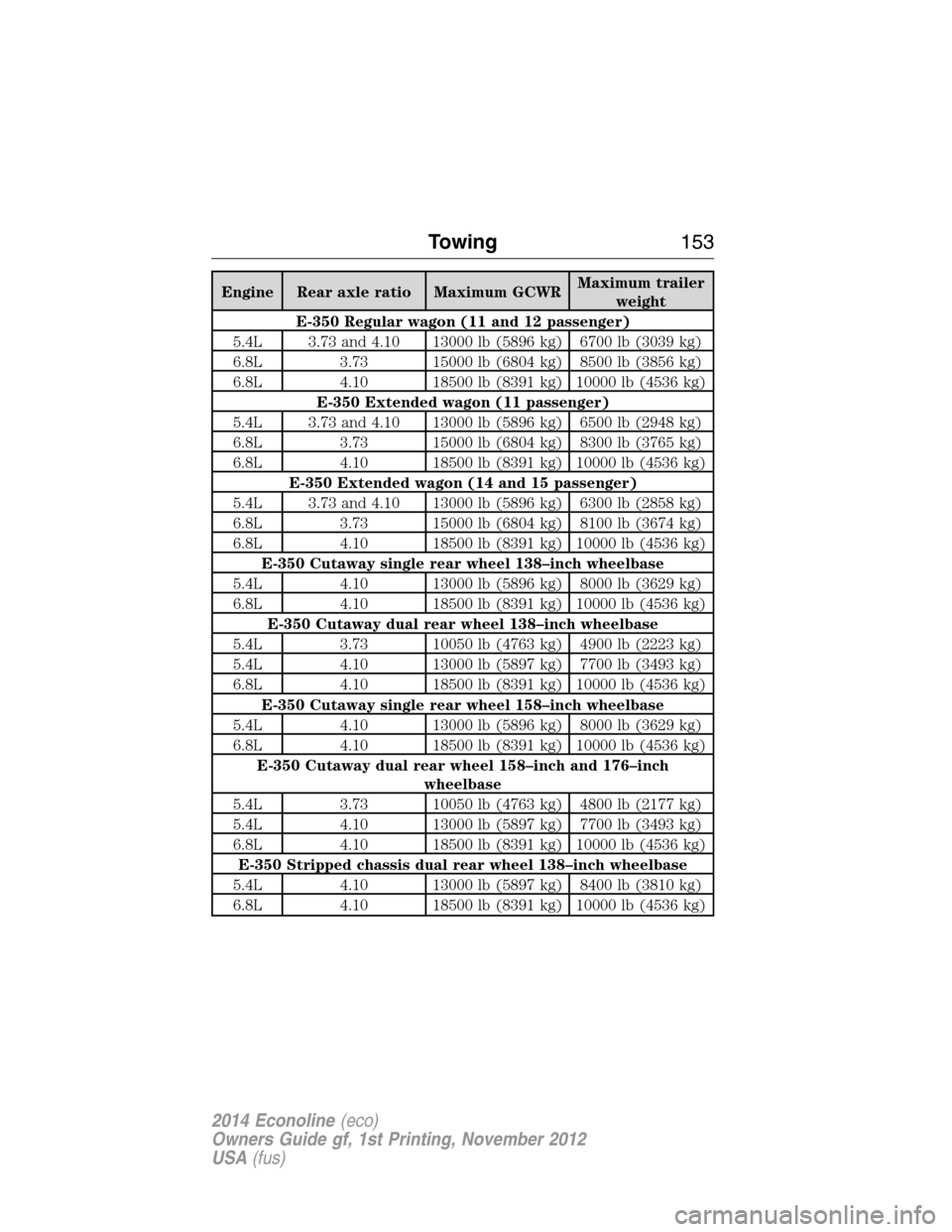
Engine Rear axle ratio Maximum GCWRMaximum trailer
weight
E-350 Regular wagon (11 and 12 passenger)
5.4L 3.73 and 4.10 13000 lb (5896 kg) 6700 lb (3039 kg)
6.8L 3.73 15000 lb (6804 kg) 8500 lb (3856 kg)
6.8L 4.10 18500 lb (8391 kg) 10000 lb (4536 kg)
E-350 Extended wagon (11 passenger)
5.4L 3.73 and 4.10 13000 lb (5896 kg) 6500 lb (2948 kg)
6.8L 3.73 15000 lb (6804 kg) 8300 lb (3765 kg)
6.8L 4.10 18500 lb (8391 kg) 10000 lb (4536 kg)
E-350 Extended wagon (14 and 15 passenger)
5.4L 3.73 and 4.10 13000 lb (5896 kg) 6300 lb (2858 kg)
6.8L 3.73 15000 lb (6804 kg) 8100 lb (3674 kg)
6.8L 4.10 18500 lb (8391 kg) 10000 lb (4536 kg)
E-350 Cutaway single rear wheel 138–inch wheelbase
5.4L 4.10 13000 lb (5896 kg) 8000 lb (3629 kg)
6.8L 4.10 18500 lb (8391 kg) 10000 lb (4536 kg)
E-350 Cutaway dual rear wheel 138–inch wheelbase
5.4L 3.73 10050 lb (4763 kg) 4900 lb (2223 kg)
5.4L 4.10 13000 lb (5897 kg) 7700 lb (3493 kg)
6.8L 4.10 18500 lb (8391 kg) 10000 lb (4536 kg)
E-350 Cutaway single rear wheel 158–inch wheelbase
5.4L 4.10 13000 lb (5896 kg) 8000 lb (3629 kg)
6.8L 4.10 18500 lb (8391 kg) 10000 lb (4536 kg)
E-350 Cutaway dual rear wheel 158–inch and 176–inch
wheelbase
5.4L 3.73 10050 lb (4763 kg) 4800 lb (2177 kg)
5.4L 4.10 13000 lb (5897 kg) 7700 lb (3493 kg)
6.8L 4.10 18500 lb (8391 kg) 10000 lb (4536 kg)
E-350 Stripped chassis dual rear wheel 138–inch wheelbase
5.4L 4.10 13000 lb (5897 kg) 8400 lb (3810 kg)
6.8L 4.10 18500 lb (8391 kg) 10000 lb (4536 kg)
Towing153
2014 Econoline(eco)
Owners Guide gf, 1st Printing, November 2012
USA(fus)
Page 155 of 438
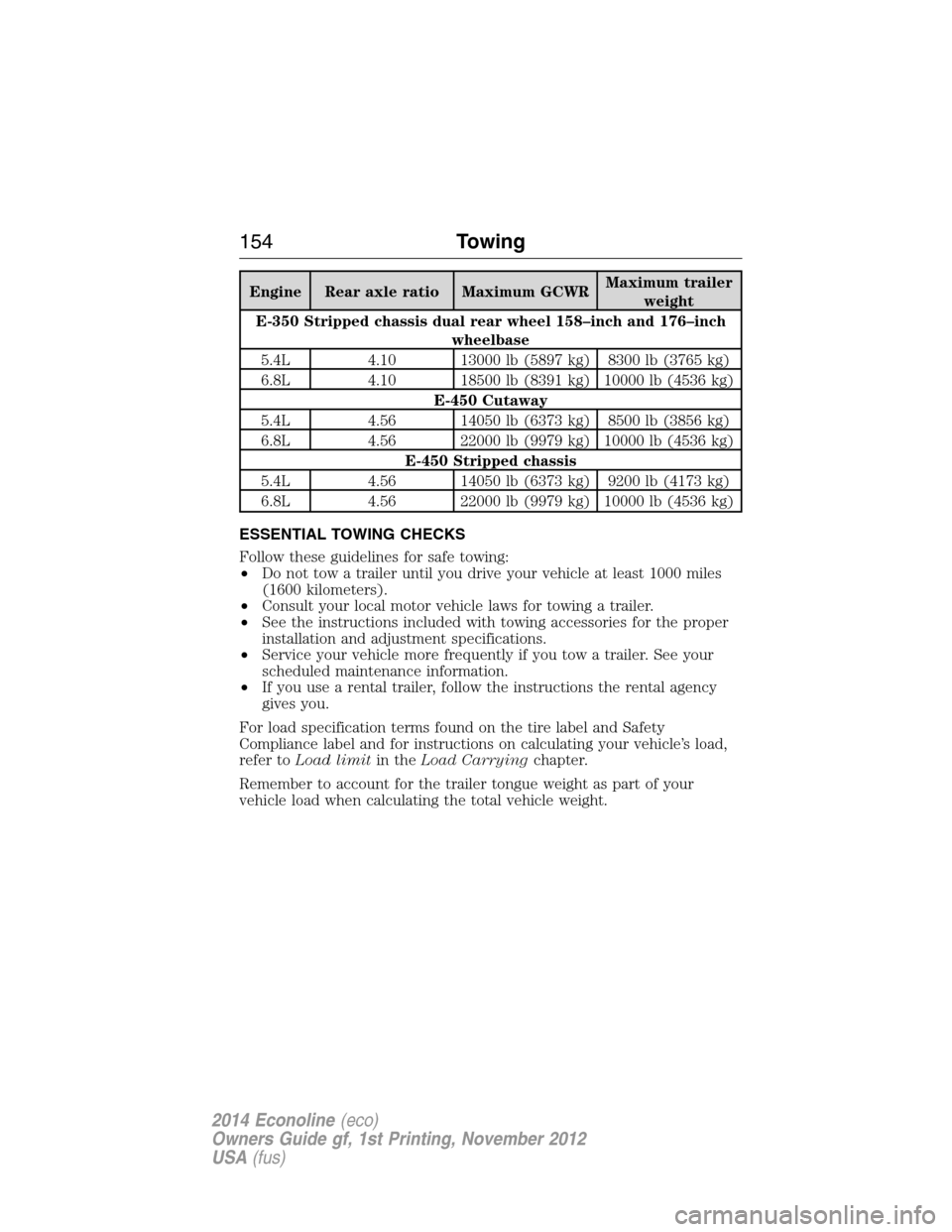
Engine Rear axle ratio Maximum GCWRMaximum trailer
weight
E-350 Stripped chassis dual rear wheel 158–inch and 176–inch
wheelbase
5.4L 4.10 13000 lb (5897 kg) 8300 lb (3765 kg)
6.8L 4.10 18500 lb (8391 kg) 10000 lb (4536 kg)
E-450 Cutaway
5.4L 4.56 14050 lb (6373 kg) 8500 lb (3856 kg)
6.8L 4.56 22000 lb (9979 kg) 10000 lb (4536 kg)
E-450 Stripped chassis
5.4L 4.56 14050 lb (6373 kg) 9200 lb (4173 kg)
6.8L 4.56 22000 lb (9979 kg) 10000 lb (4536 kg)
ESSENTIAL TOWING CHECKS
Follow these guidelines for safe towing:
•Do not tow a trailer until you drive your vehicle at least 1000 miles
(1600 kilometers).
•Consult your local motor vehicle laws for towing a trailer.
•See the instructions included with towing accessories for the proper
installation and adjustment specifications.
•Service your vehicle more frequently if you tow a trailer. See your
scheduled maintenance information.
•If you use a rental trailer, follow the instructions the rental agency
gives you.
For load specification terms found on the tire label and Safety
Compliance label and for instructions on calculating your vehicle’s load,
refer toLoad limitin theLoad Carryingchapter.
Remember to account for the trailer tongue weight as part of your
vehicle load when calculating the total vehicle weight.
154Towing
2014 Econoline(eco)
Owners Guide gf, 1st Printing, November 2012
USA(fus)
Page 156 of 438

Trailer Towing Connector (Vehicles with a Trailer Towing Package
and 7–Pin Connector)
When attaching the trailer wiring
connector to your vehicle, only use
a proper fitting connector that
works with the vehicle and trailer
functions. If your vehicle has a
trailer towing package, it may have
a 7–pin connector. Some connectors
may have the SAE J2863 logo,
which confirms that it is the proper
wiring connector and works correctly with your vehicle.
Color Function
1. Yellow Left turn signal and stop lamp
2. White Ground (-)
3. Blue Electric brakes
4. Green Right turn signal and stop lamp
5. Orange Battery (+)
6. Brown Running lights
7. Grey Reverse lights
Hitches
Do not use a hitch that either clamps onto the bumper or attaches to the
axle.
Distribute the trailer load so 10-15% of the total trailer weight is on the
tongue.
Weight-Distributing Hitches
WARNING:Do not adjust a weight-distributing hitch to any
position where the rear bumper of the vehicle is higher than it
was before attaching the trailer. Doing so will defeat the function of the
weight-distributing hitch, which may cause unpredictable handling, and
could result in serious personal injury.
When hooking-up a trailer using a weight-distributing hitch, always use
the following procedure:
1. Park the loaded vehicle, without the trailer, on a level surface.
2. Measure the height to the top of your vehicle’s front wheel opening
on the fender. This is H1.
Towing155
2014 Econoline(eco)
Owners Guide gf, 1st Printing, November 2012
USA(fus)
Page 157 of 438
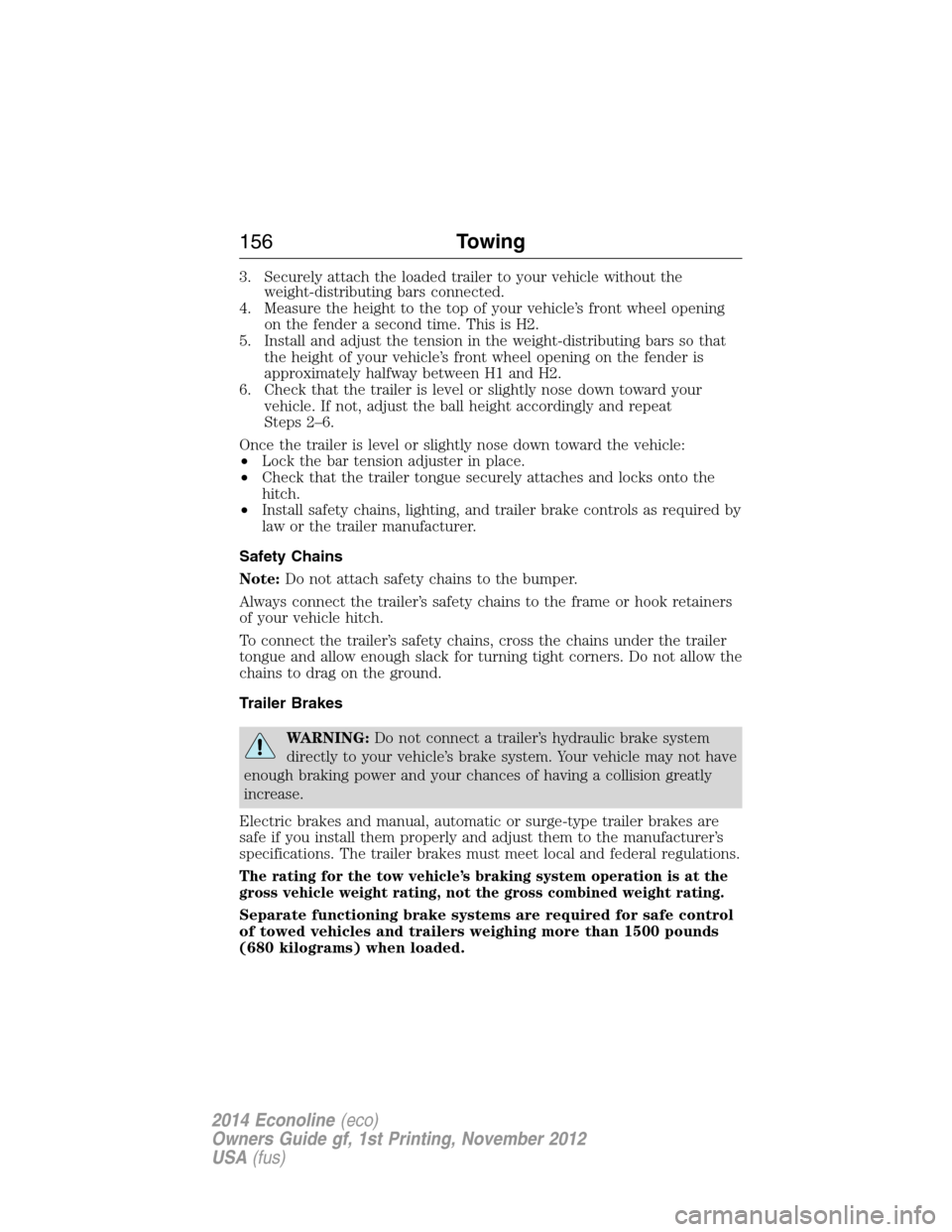
3. Securely attach the loaded trailer to your vehicle without the
weight-distributing bars connected.
4. Measure the height to the top of your vehicle’s front wheel opening
on the fender a second time. This is H2.
5. Install and adjust the tension in the weight-distributing bars so that
the height of your vehicle’s front wheel opening on the fender is
approximately halfway between H1 and H2.
6. Check that the trailer is level or slightly nose down toward your
vehicle. If not, adjust the ball height accordingly and repeat
Steps 2–6.
Once the trailer is level or slightly nose down toward the vehicle:
•Lock the bar tension adjuster in place.
•Check that the trailer tongue securely attaches and locks onto the
hitch.
•Install safety chains, lighting, and trailer brake controls as required by
law or the trailer manufacturer.
Safety Chains
Note:Do not attach safety chains to the bumper.
Always connect the trailer’s safety chains to the frame or hook retainers
of your vehicle hitch.
To connect the trailer’s safety chains, cross the chains under the trailer
tongue and allow enough slack for turning tight corners. Do not allow the
chains to drag on the ground.
Trailer Brakes
WARNING:Do not connect a trailer’s hydraulic brake system
directly to your vehicle’s brake system. Your vehicle may not have
enough braking power and your chances of having a collision greatly
increase.
Electric brakes and manual, automatic or surge-type trailer brakes are
safe if you install them properly and adjust them to the manufacturer’s
specifications. The trailer brakes must meet local and federal regulations.
The rating for the tow vehicle’s braking system operation is at the
gross vehicle weight rating, not the gross combined weight rating.
Separate functioning brake systems are required for safe control
of towed vehicles and trailers weighing more than 1500 pounds
(680 kilograms) when loaded.
156Towing
2014 Econoline(eco)
Owners Guide gf, 1st Printing, November 2012
USA(fus)
Page 158 of 438
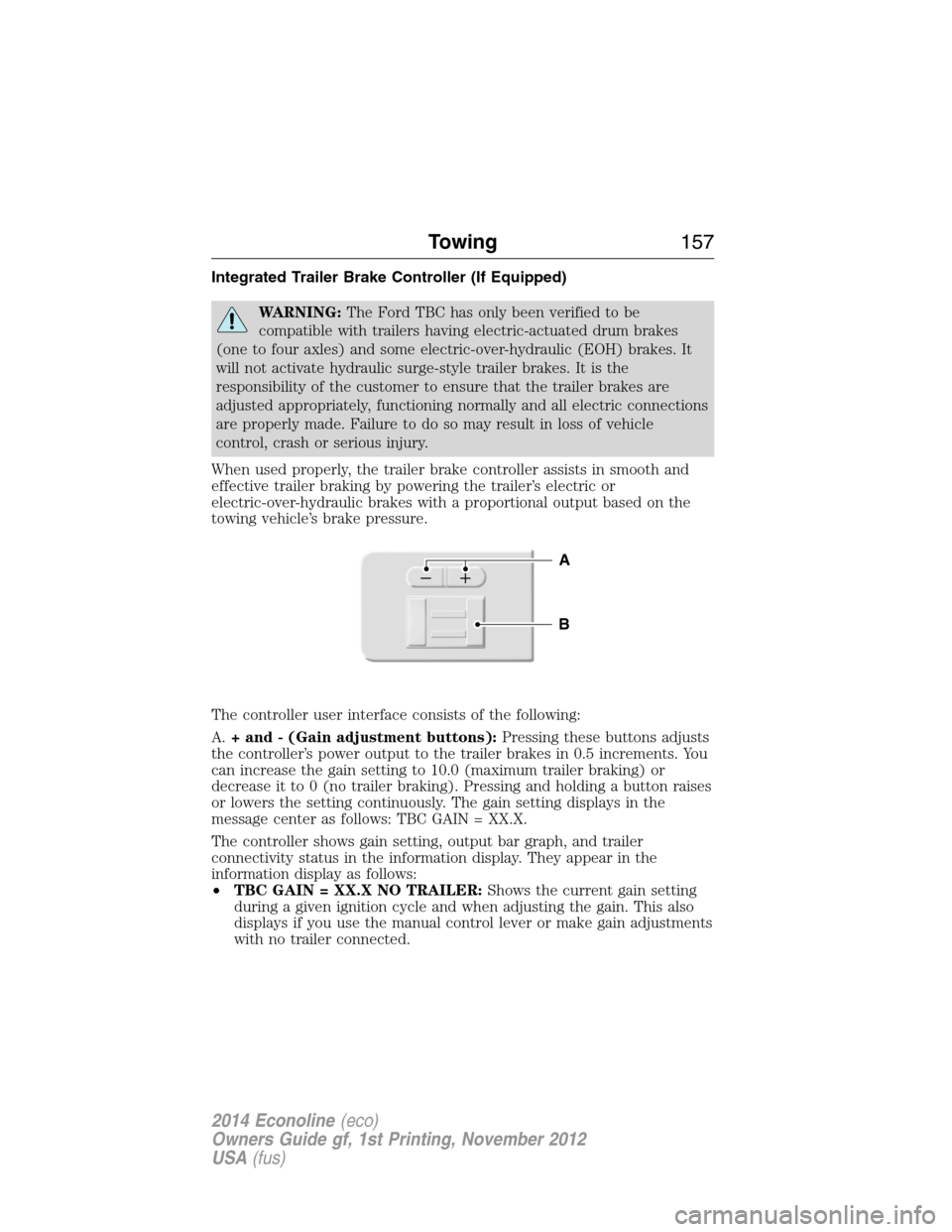
Integrated Trailer Brake Controller (If Equipped)
WARNING:The Ford TBC has only been verified to be
compatible with trailers having electric-actuated drum brakes
(one to four axles) and some electric-over-hydraulic (EOH) brakes. It
will not activate hydraulic surge-style trailer brakes. It is the
responsibility of the customer to ensure that the trailer brakes are
adjusted appropriately, functioning normally and all electric connections
are properly made. Failure to do so may result in loss of vehicle
control, crash or serious injury.
When used properly, the trailer brake controller assists in smooth and
effective trailer braking by powering the trailer’s electric or
electric-over-hydraulic brakes with a proportional output based on the
towing vehicle’s brake pressure.
The controller user interface consists of the following:
A.+ and - (Gain adjustment buttons):Pressing these buttons adjusts
the controller’s power output to the trailer brakes in 0.5 increments. You
can increase the gain setting to 10.0 (maximum trailer braking) or
decrease it to 0 (no trailer braking). Pressing and holding a button raises
or lowers the setting continuously. The gain setting displays in the
message center as follows: TBC GAIN = XX.X.
The controller shows gain setting, output bar graph, and trailer
connectivity status in the information display. They appear in the
information display as follows:
•TBC GAIN = XX.X NO TRAILER:Shows the current gain setting
during a given ignition cycle and when adjusting the gain. This also
displays if you use the manual control lever or make gain adjustments
with no trailer connected.
B
A
Towing157
2014 Econoline(eco)
Owners Guide gf, 1st Printing, November 2012
USA(fus)
Page 159 of 438
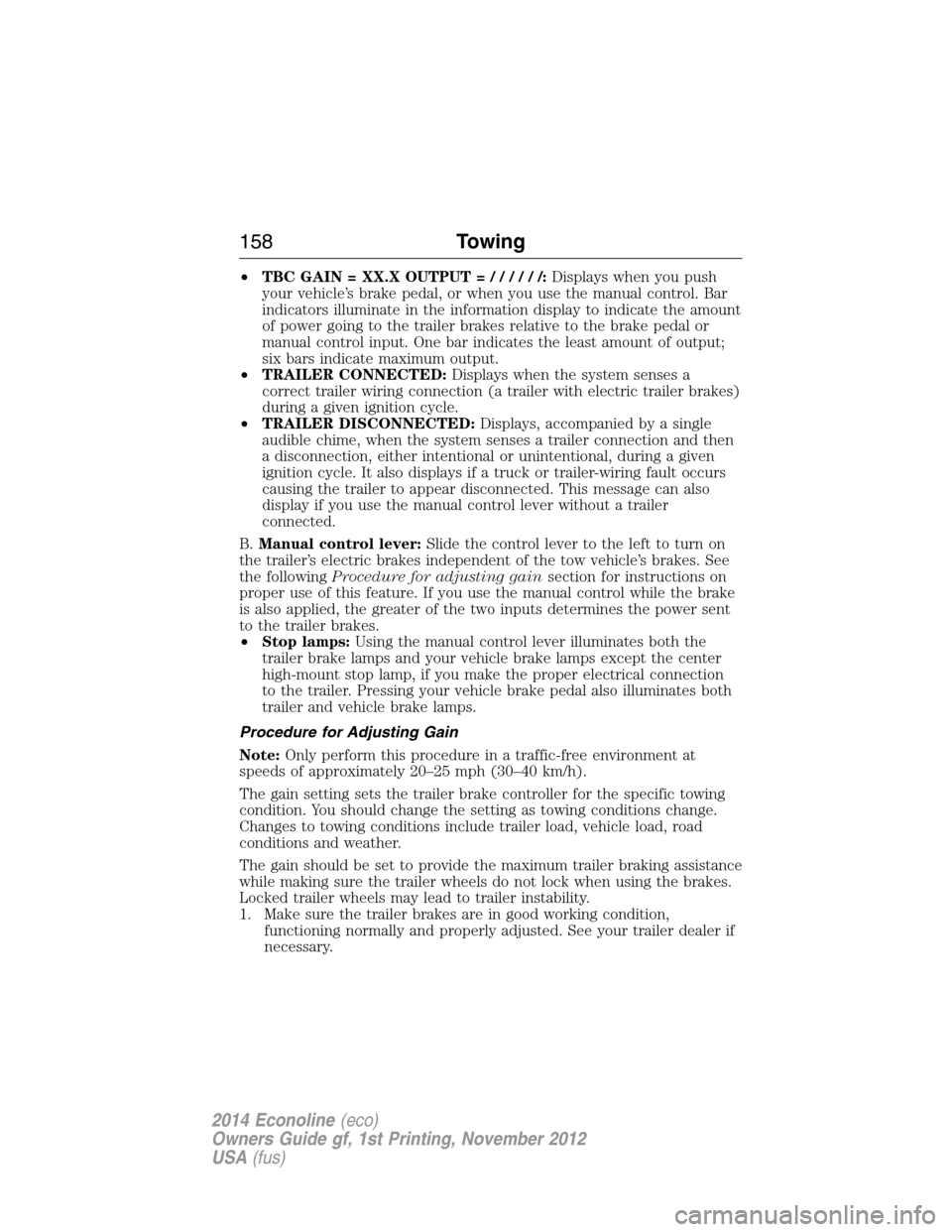
•TBC GAIN = XX.X OUTPUT=//////:Displays when you push
your vehicle’s brake pedal, or when you use the manual control. Bar
indicators illuminate in the information display to indicate the amount
of power going to the trailer brakes relative to the brake pedal or
manual control input. One bar indicates the least amount of output;
six bars indicate maximum output.
•TRAILER CONNECTED:Displays when the system senses a
correct trailer wiring connection (a trailer with electric trailer brakes)
during a given ignition cycle.
•TRAILER DISCONNECTED:Displays, accompanied by a single
audible chime, when the system senses a trailer connection and then
a disconnection, either intentional or unintentional, during a given
ignition cycle. It also displays if a truck or trailer-wiring fault occurs
causing the trailer to appear disconnected. This message can also
display if you use the manual control lever without a trailer
connected.
B.Manual control lever:Slide the control lever to the left to turn on
the trailer’s electric brakes independent of the tow vehicle’s brakes. See
the followingProcedure for adjusting gainsection for instructions on
proper use of this feature. If you use the manual control while the brake
is also applied, the greater of the two inputs determines the power sent
to the trailer brakes.
•Stop lamps:Using the manual control lever illuminates both the
trailer brake lamps and your vehicle brake lamps except the center
high-mount stop lamp, if you make the proper electrical connection
to the trailer. Pressing your vehicle brake pedal also illuminates both
trailer and vehicle brake lamps.
Procedure for Adjusting Gain
Note:Only perform this procedure in a traffic-free environment at
speeds of approximately 20–25 mph (30–40 km/h).
The gain setting sets the trailer brake controller for the specific towing
condition. You should change the setting as towing conditions change.
Changes to towing conditions include trailer load, vehicle load, road
conditions and weather.
The gain should be set to provide the maximum trailer braking assistance
while making sure the trailer wheels do not lock when using the brakes.
Locked trailer wheels may lead to trailer instability.
1. Make sure the trailer brakes are in good working condition,
functioning normally and properly adjusted. See your trailer dealer if
necessary.
158Towing
2014 Econoline(eco)
Owners Guide gf, 1st Printing, November 2012
USA(fus)
Page 160 of 438
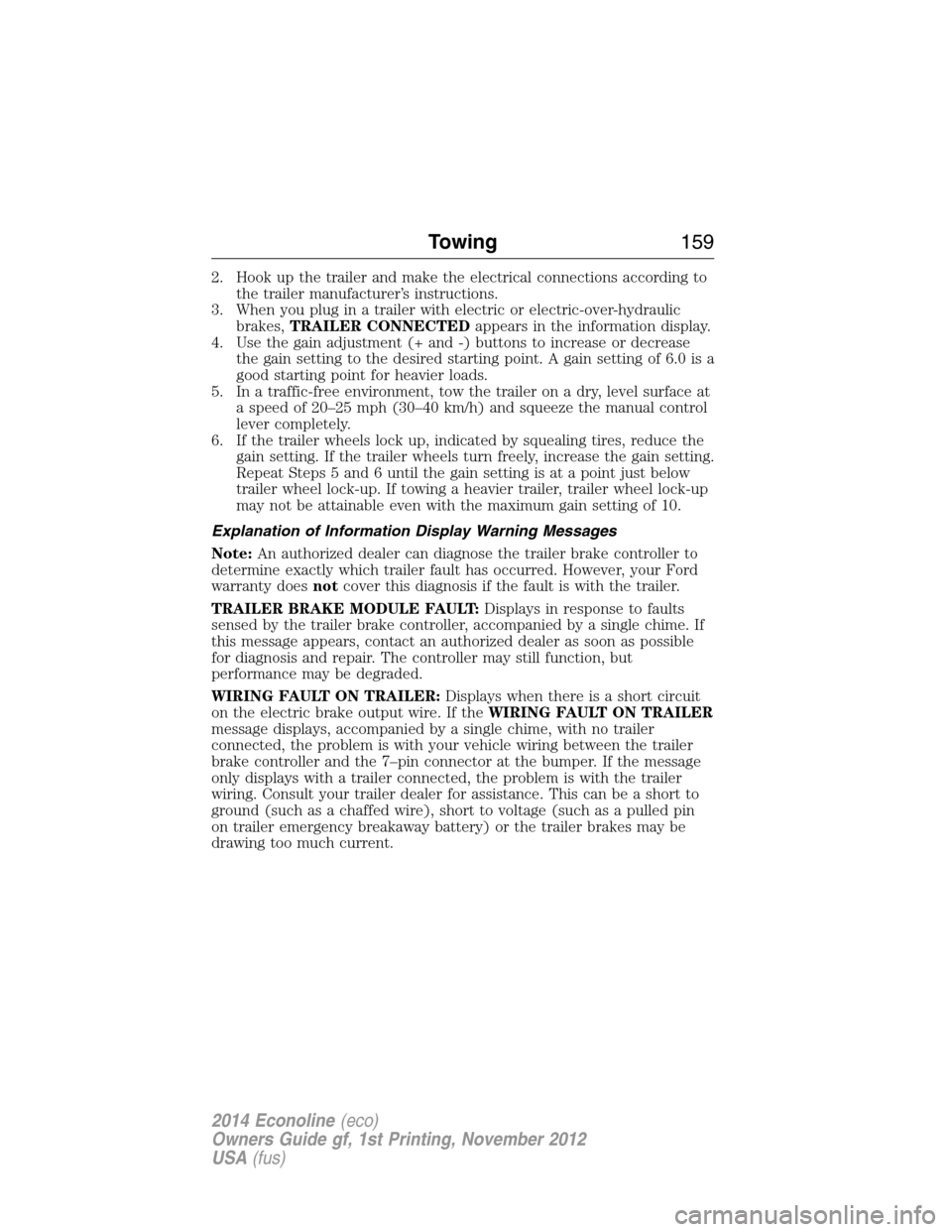
2. Hook up the trailer and make the electrical connections according to
the trailer manufacturer’s instructions.
3. When you plug in a trailer with electric or electric-over-hydraulic
brakes,TRAILER CONNECTEDappears in the information display.
4. Use the gain adjustment (+ and -) buttons to increase or decrease
the gain setting to the desired starting point. A gain setting of 6.0 is a
good starting point for heavier loads.
5. In a traffic-free environment, tow the trailer on a dry, level surface at
a speed of 20–25 mph (30–40 km/h) and squeeze the manual control
lever completely.
6. If the trailer wheels lock up, indicated by squealing tires, reduce the
gain setting. If the trailer wheels turn freely, increase the gain setting.
Repeat Steps 5 and 6 until the gain setting is at a point just below
trailer wheel lock-up. If towing a heavier trailer, trailer wheel lock-up
may not be attainable even with the maximum gain setting of 10.
Explanation of Information Display Warning Messages
Note:An authorized dealer can diagnose the trailer brake controller to
determine exactly which trailer fault has occurred. However, your Ford
warranty doesnotcover this diagnosis if the fault is with the trailer.
TRAILER BRAKE MODULE FAULT:Displays in response to faults
sensed by the trailer brake controller, accompanied by a single chime. If
this message appears, contact an authorized dealer as soon as possible
for diagnosis and repair. The controller may still function, but
performance may be degraded.
WIRING FAULT ON TRAILER:Displays when there is a short circuit
on the electric brake output wire. If theWIRING FAULT ON TRAILER
message displays, accompanied by a single chime, with no trailer
connected, the problem is with your vehicle wiring between the trailer
brake controller and the 7–pin connector at the bumper. If the message
only displays with a trailer connected, the problem is with the trailer
wiring. Consult your trailer dealer for assistance. This can be a short to
ground (such as a chaffed wire), short to voltage (such as a pulled pin
on trailer emergency breakaway battery) or the trailer brakes may be
drawing too much current.
Towing159
2014 Econoline(eco)
Owners Guide gf, 1st Printing, November 2012
USA(fus)